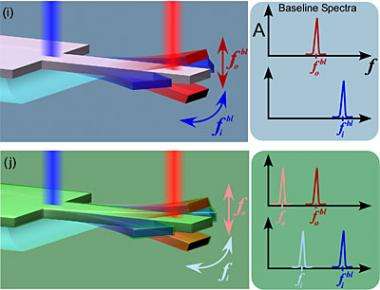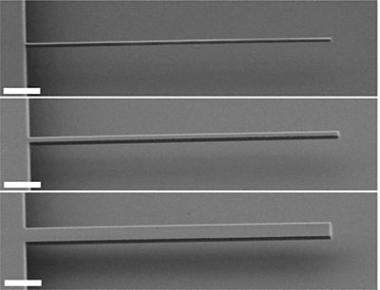Vibrating nanorods measure thin films for microcircuits

(PhysOrg.com) -- A key step in many nanofabrication processes is to create thin films, sometimes only one molecule thick, by a method known as atomic layer deposition. Researchers at Cornell and Tel Aviv University have developed a new tool for nanofabricators to test the physical properties of such films.
Ultrathin films are increasingly important in constructing microcircuits. Their physical characteristics often determine their electronic behavior as well as their resistance to wear.
The researchers have shown that tiny resonant cantilevers -- silicon rods anchored at one end, like a tiny diving board -- can determine the density of a film and its Young's modulus, a measure of resistance to bending. The method offers several advantages over other methods of measuring these characteristics of thin films, the researchers said, and can be used by any researchers with access to nanofabrication capabilities comparable to those at the Cornell Nanoscale Facility.
The work was reported in the Aug. 15 issue of the Journal of Applied Physics by Cornell research associate Rob Ilic, Slava Krylov, senior lecturer at Tel Aviv University and former visiting professor at Cornell, and Harold Craighead, the C.W. Lake Jr. Professor of Engineering at Cornell.

Cornell researchers have previously used tiny vibrating cantilevers just a few nanometers (billionths of a meter) thick to detect the mass of objects as small as a virus. Just as a thick guitar string vibrates at a lower note than a thinner one, adding mass to a vibrating rod changes its frequency of vibration. Coating the rod with a thin film adds detectable mass, and from the mass and thickness of the film, density can be determined.
The film also changes the cantilever's resistance to bending. To separate out this characteristic, the researchers compared in-plane (side to side) and out-of-plane (up and down) vibrations. The resistance to bending in different directions is noticeably different when the vibrating rod is wide and thin. When the cross-section of the rod is square, there is no difference between up and down and side-to-side movement.
To test their idea, the researchers fabricated a variety of cantilevers six to 10 microns (millionths of a meter) long, 45 nanometers thick and with widths varying from 45 nanometers to 1 micron. In various experiments, they applied films of aluminum, aluminum nitride and hafnium from 21.2 to 21.5 nanometers thick to the surface of the cantilevers.
A laser beam focused on the base of a cantilever supplies energy to set it vibrating, and another laser aimed at the end measures the vibration. Like a tuning fork, each rod has a resonant frequency at which it vibrates, and that depends on the dimensions and physical characteristics of the device. Comparing the resonant frequency and some of its harmonics before and after a film was applied enabled the researchers to calculate the density and Young's modulus of the film.
Over many experiments, the calculations agreed well with theoretical predictions and characteristics of films measured by other methods. Some aspects of the method of fabricating the nanocantilevers could affect the results, the researchers found, but they said accuracy could be improved.
The work was supported by the Defense Advanced Projects Research Administration, the National Science Foundation and the state of New York.
Provided by Cornell University

















